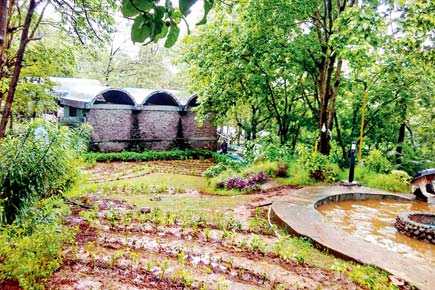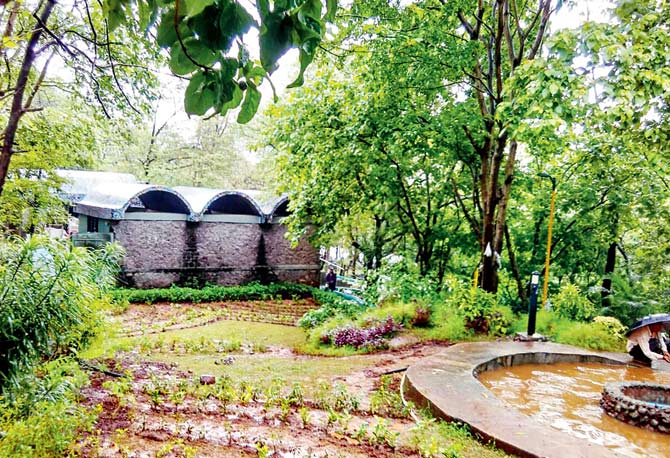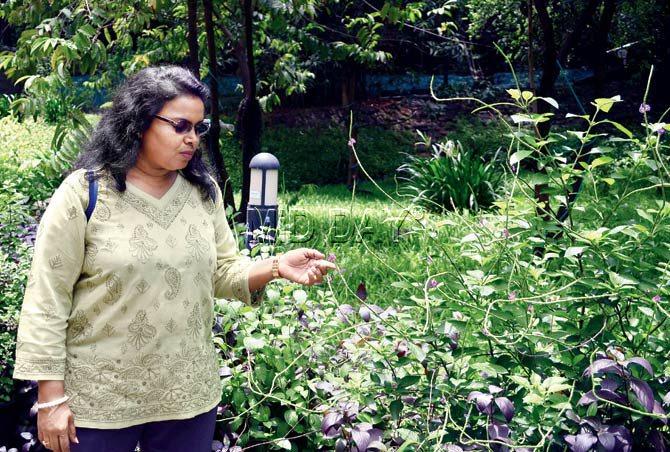Entomologist Dr V Shubhalaxmi is making room for the pretty brand ambassadors of the insect world, one habitat at a time

 It is a sunny morning in the middle of a Mumbai monsoon when we meet Dr V Shubhalaxmi, or the 'The Bug Lady', as she calls herself. She is not kidding — she wears an understated gold ring with gemstones set in the shape of a butterfly and her mobile phone chirps like a cricket when it rings. The entomologist, who formerly worked with the Bombay Natural History Society (BNHS) before setting up her own environment consulting firm, has undertaken a mission to woo butterflies back into our lives. And, she is tempting them with places to stay, eat and shack up — in essence, a habitat.
It is a sunny morning in the middle of a Mumbai monsoon when we meet Dr V Shubhalaxmi, or the 'The Bug Lady', as she calls herself. She is not kidding — she wears an understated gold ring with gemstones set in the shape of a butterfly and her mobile phone chirps like a cricket when it rings. The entomologist, who formerly worked with the Bombay Natural History Society (BNHS) before setting up her own environment consulting firm, has undertaken a mission to woo butterflies back into our lives. And, she is tempting them with places to stay, eat and shack up — in essence, a habitat.
 The two-week-old butterfly habitat at Urban Haat, Belapur
The two-week-old butterfly habitat at Urban Haat, Belapur
ADVERTISEMENT
"It started with corporates approaching me for tree plantation drives as part of their CSR activity. I suggested that they could do more for local biodiversity if they just took it a step ahead. You could create an ecosystem instead of just planting trees," says Shubhalaxmi. In the span of one year, she has been the brain behind six butterfly gardens, including spots at Maharashtra Nature Park and Mulund's CD Deshmukh Udyan.

Dr V Shubhalaxmi points out to Jamaican spike, a butterfly attracting plant with tiny flowers, at Urban Haat. Pic/Sneha Kharabe
We meet her at Urban Haat, in the business headquarters of CBD Belapur in Navi Mumbai. Urban Haat is a sprawling, verdant hilltop in which is an integrated crafts bazaar — you could call it a mall in the wilderness. Shubhalaxmi takes us through the winding paved road and shops with their shutters down, to a fork in the path where a board reads "Butterfly Garden".
Conceptualised by Shubhalaxmi for a corporate's CSR programme, the garden is just two weeks old. It is hard to believe that in this 2,400 sq ft land, there are a thousand plants, all of them meant to seduce butterflies. On the outer fringe are the taller shrubs, like oleander, shankasur and lemon. In the inner rows are smaller ones like ixora, Jamaican spike and bryophyllum. Unlike roses, dahlias and chrysanthemums, these flowering plants are quite underwhelming. But, that's the secret, says Shubhalaxmi. The smaller and more tubular the flower, the better it attracts the proboscis-bearing butterflies.
Shubhalaxmi terms this a habitat; hundred plants make a garden, a thousand make a habitat. "But garden sounds more inviting than a habitat for human visitors, right?" she says.
Insect brand ambassador
The concept of a butterfly garden in the city has been around ever since Rajendra Ovalekar, guided by India's Butterfly Man Issac Kehimkar, created one in Thane's Ovalekarwadi. That was nearly a decade ago, and the site has seen its fair share of visitors. Kehimkar, whose second book on butterflies comes out next month, says that there has been a renewed interest in butterflies in recent years thanks to photography enthusiasts and social media. Kehimkar says that this interest has led to an increase in spotting new butterfly species in the city. Currently, there are about 150-165 species. The sad story is that most are restricted to areas of intense vegetation, such as Sanjay Gandhi National Park.
Recently, the Thane Municipal Corporation floated a tender to build a butterfly park in Manpada at a cost of R58 lakhs. The 88,000 sq ft park is intended to be an eco-tourist destination and a biodiversity site that will encourage avian visitors, too. But, there is more to butterflies than just being eye-candy, urge Shubhalaxmi and Kehimkar. "These fragile creatures are indicators of a micro-habitat," says Shubhalaxmi. "They pick up the minutest changes in a micro-climate, such as pollution levels, and get affected. If we watch the butterfly population closely, it gives us time to rectify our damage to ecosystems before it affects bigger species like tigers," she continues.
But, there's more to butterfly habitats than just conservation centres for these glamorous brand ambassadors of the insect world. A year ago, Shubhalaxmi conceptualised a butterfly habitat in Jawhar, a hill station about 145 km from Mumbai. Created with CSR funding and the support of non-profit BAIF MITTRA, the habitat is situated in the premises of a school surrounded by farmlands. The butterfly tourists to this habitat are hoped to work as pollinators for the farms around.
The cost of building a butterfly habitat, such as the one in Urban Haat, and maintaining it for a year is about Rs 2.2 lakh. However, more intensive and long-term projects can go up to Rs 18 lakh.
The problem, strangely, is not funding, but getting officials and citizens to literally think out of the box. "Abroad, in the USA and Singapore, there are just fewer species of butterflies, so the concept of enclosed butterflies is popular. In these set-ups, there is a production line for breeding butterflies, and their mortality rate is very high. However, in India, we have a rich biodiversity and, therefore, instead of caging butterflies, we have the luxury of enjoying them in the open," she says.
As we walk out of Urban Haat, Shubhalaxmi talks about all this attention showered upon the butterflies. What about the lesser mortals of the insect world? "Fireflies are now getting celebrity status thanks to monsoon treks and camps, but it is not enough to enjoy pretty insects. What about the not-so-pretty ones?" she asks.
 Subscribe today by clicking the link and stay updated with the latest news!" Click here!
Subscribe today by clicking the link and stay updated with the latest news!" Click here!







